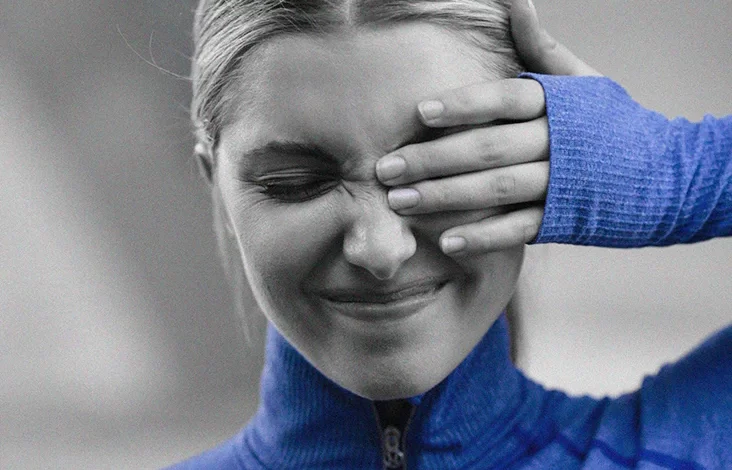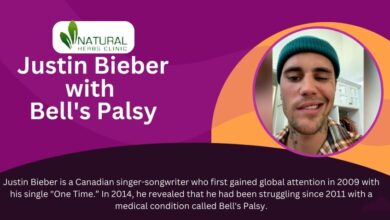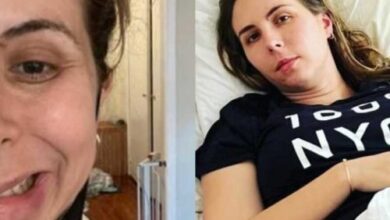Difficulty Closing One Eye and Smiling Problems

Struggling to close one eye and smile? Get Knowledge about the possible causes of this common issue Difficulty Closing One Eye.
Difficulty Closing One Eye and Bell’s Palsy
Having difficulty closing one eye and smiling is a symptom that could be related to Bell’s Palsy. Bell’s Palsy, also known as facial palsy, is a type of nerve damage that affects the ability to move one side of the face. It is usually caused by inflammation or swelling of the facial nerve, which controls muscles in the face. Symptoms include temporary paralysis or weakness on one side of the face, drooping eyelids, difficulty closing one eye and smiling, and loss of taste in the front two-thirds of the tongue. Fortunately, most people who experience these symptoms make a full recovery within three weeks with proper treatment.
What Causes Difficulty Closing One Eye?
The most common cause for difficulty closing one eye is Bell’s Palsy. This condition occurs when something compresses or damages the facial nerve (also known as cranial nerve VII), which controls movement in your face and mouth. In addition to difficulty closing one eye and smiling, other common symptoms include dry eyes or mouth, drooping eyelids, uneven smile, numbness in parts of your face, twitching of your cheek muscles or lips, headaches around your ear or temple area and reduced taste sensation on the front two-thirds of your tongue.
Who Is at Risk for Bell’s Palsy?
Anyone can develop Bell’s Palsy although it may occur more frequently in people with certain conditions such as diabetes mellitus and HIV/AIDS infection. Age also plays a role; younger adults between 15-45 years are more likely to develop this condition than those outside this age range. Other factors that may increase risk include pregnancy (especially during the third trimester), viral infections (such as herpes simplex virus 1) and post-viral illnesses like colds and influenza
Treating Difficulty Closing One Eye
If you experience any difficulties closing one eye or notice any other symptoms associated with Bell’s Palsy it is important to seek medical advice from your doctor right away so they can determine whether further tests are needed to diagnose you appropriately and begin treatment accordingly. Treatment for this condition usually involves medications such as steroids (prednisone), antiviral drugs (acyclovir) and physical therapy techniques such as massage therapy to reduce swelling around the affected facial muscles. Some doctors may also recommend acupuncture or other relaxation techniques to help reduce stress levels which can exacerbate symptoms associated with Bell’s palsy.
Causes of Difficulty Closing One Eye and Smiling Problems
Difficulty closing one eye and smiling is a symptom of Bell’s Palsy, a condition that results in temporary paralysis or weakness in the facial muscles. It is caused by damage to the 7th cranial nerve (also called the facial nerve), which controls facial muscles on the affected side. Bell’s Palsy causes the face to droop or sag on one side, making it difficult for people to close their eyes or smile. Other symptoms include a feeling of tightness or pain in the face, decreased taste on one side of the tongue, drooling, and an inability to produce tears. There are a variety of causes for Bell’s Palsy, including viruses such as herpes simplex type 1 (the virus responsible for cold sores) and Lyme disease, an infection caused by a tick bite.
Other potential causes are diabetes, head trauma from an injury, stroke, tumors, brain surgery or an immune disorder. Stress can also be a factor in Bell’s Palsy development as it can weaken your immune system and make you more susceptible to infections that can cause this condition. Diagnosis is performed through medical history and physical examination. An MRI may be used to detect any tumors or other underlying conditions that could be causing difficulty closing one eye and smiling problems. Treatment typically involves antiviral medications if a virus is detected as well as steroids to reduce inflammation of the nerve. Physical therapy can also help restore facial muscle control and mobility while reducing pain associated with Bell’s Palsy. In some cases, surgery may be necessary to repair damage to the nerve from trauma or tumor growth.
Symptoms of Difficulty Closing One Eye and Smiling Problems
Difficulty closing one eye, or a condition known as Bell’s Palsy, can cause temporary paralysis of the muscles on one side of the face. This form of paralysis can lead to difficulty closing one eye when smiling or blinking. Other symptoms may include vulnerability to eye dryness on the affected side, as well as losses of sensation or feeling in the affected area. Additionally, it is possible to experience headaches and pain in and around the ear. The most common symptom associated with Bell’s Palsy is sudden weakness or total paralysis on one side of the face. Generally, once an individual notices any type of facial paralysis, they should seek medical attention immediately. A doctor will assess their condition and may order further tests such as a MRI or CT scan to diagnose any underlying issues causing the difficulty closing an eye when smiling.
The primary cause of Bell’s Palsy is believed to be a virus that attacks a facial nerve – often caused by prolonged exposure to cold weather or stress. In some cases, an injury or illness can also cause difficulty closing one eye when smiling. As such, it is always important for individuals with facial paralysis to consult a doctor for diagnosis and treatment options. Bell’s Palsy Treatment typically consists of antiviral medications to reduce inflammation and swelling in the affected area, as well as physical therapy exercises that help restore muscle tone in the affected parts of the face. Besides medical intervention, at-home remedies such as warm compresses can also help improve circulation in the affected area which may speed up recovery time. Overall, if an individual experiences difficulty closing one eye when smiling it is important that they make an appointment with their doctor promptly for assessment and treatment plan options.
Diagnosis of Difficulty Closing One Eye and Smiling Problems
Individuals suffering from difficulty closing one eye and smiling problems can find the diagnosis and treatment of their condition confusing. Difficulty closing one eye and smiling problems can be caused by a variety of conditions, such as Bell’s Palsy, facial nerve damage, or a combination of other conditions. It is important to correctly diagnose the cause of the problem in order to ensure proper treatment. In order to accurately diagnose difficulty closing one eye and smiling problems, a physician will perform a physical examination along with neurological tests. This examination includes looking at facial muscle tone and any changes in the patient’s eyes such as drooping eyelids or unequal pupil size. Depending on the individual’s symptoms, additional tests may be required such as an MRI or CT scan. The most common cause for difficulty closing one eye and smiling problems is Bell’s Palsy, which is a type of facial nerve paralysis. This condition is caused by inflammation or damage to the facial nerve resulting in paralysis on one side of the face. In some cases, Bell’s Palsy will resolve on its own without treatment; however, early diagnosis and treatment are essential for achieving positive results. Treatment for Bell’s Palsy often involves physical therapy, medications, acupuncture, electrical stimulation, or surgery depending on severity.
Bell’s Palsy Treatment typically involves medications designed to reduce inflammation along with steroids to help prevent tissue damage. Other treatments may include antiviral medications if viral infections are suspected as the cause of Bell’s Palsy. Some physicians may recommend using devices like eyeglasses that can help hold an eyelid closed when it droops due to Bell’s Palsy. Physical therapy exercises can also help strengthen weakened facial muscles affected by Bell’s palsy allowing them to heal quicker while helping restore normal movement in the face. It is important to seek medical attention for difficulty closing one eye and smiling problems as soon as possible in order to ensure proper diagnosis and timely treatment. A correct diagnosis provides individuals with increased chances for positive outcomes through appropriate treatments tailored to their specific needs.
Treatment Options for Difficulty Closing One Eye and Smiling Problems
Difficulty closing one eye and smiling problems can be caused by a variety of conditions, such as Bell’s Palsy. Bell’s Palsy can result in the facial nerve becoming inflamed or swollen, which then leads to the inability to close an eye completely. Fortunately, there are several treatment options available to help alleviate the condition and help improve any symptoms experienced.
Medication
One of the most common treatments for difficulty closing one eye and smiling problems is medication. Medication may include steroids or antiviral drugs, depending on the severity of your condition. Steroids can help reduce inflammation, while antiviral drugs may be used to stop any further spread of infection. Your doctor may also prescribe a muscle relaxant if needed, which helps reduce spasms in your facial muscles that can contribute to difficulty closing one eye and smiling problems.
Physical Therapy
Physical therapy is another option that you should consider if you’re suffering from difficulty closing one eye and smiling problems. This type of therapy involves exercises with specific movements that help to strengthen the muscles in your face. These exercises focus on helping re-establish control over your facial expressions and improve range of motion in your face so that you can close both eyes completely when you smile or blink.
Surgery
In some cases, surgery may be necessary if other treatments don’t work or if complications have developed due to Bell’s Palsy. Surgery may involve removing small amounts of tissue from around the affected area or using a laser to repair damaged nerves and muscles in order to restore proper function in the facial area affected by Bell’s Palsy. This type of surgery carries risks, so it should only be considered as a last resort after other treatments have failed or if more serious complications have arisen from Bell’s Palsy. Overall, there are many treatment options available for those dealing with difficulty closing one eye and smiling problems due to Bell’s Palsy. It is important to discuss all options with your doctor before starting any treatment plan so that you can find the best solution for you and ensure you get the most effective treatment possible for success in restoring normal function in your face.
Prevention Tips for Difficulty Closing One Eye and Smiling Problems
Difficulty closing one eye and smiling problems, also known as Bell’s Palsy, can be an extremely distressing condition. Fortunately, there are some prevention tips you can take to minimize the risks of developing this condition. Taking preventive measures such as avoiding stress and getting regular exercise can help reduce your risk of Bell’s Palsy. Additionally, eating a balanced diet and getting enough sleep are also crucial for prevention.
Avoid Stress
Stress is one of the most commonly cited causes of Bell’s Palsy. While it is impossible to avoid all stressors in life, it is important to do what you can to manage stress levels in order to prevent this condition from occurring. Taking time out for yourself each day to relax or engaging in activities that help you manage stress can be beneficial. Additionally, if you feel overwhelmed with stress, consider seeking professional counseling or therapy to learn how to better manage stress levels.
Regular Exercise
Exercising regularly can help reduce your risk of developing Bell’s Palsy by improving circulation throughout the body and strengthening the immune system. Aim for at least 150 minutes of moderate activity per week such as brisk walking or jogging, swimming or cycling. Additionally, engaging in strength training can also help improve muscle strength around the face which may reduce your risk of facial nerve damage due to Bell’s Palsy.
Balanced Diet
Eating a healthy balanced diet will go a long way towards preventing the onset of Bell’s Palsy. A nutritious diet gives your body the vitamins and minerals it needs to stay healthy which reduces your risk of developing any type of illness including this condition. Make sure you eat plenty of fresh fruits and vegetables as well as lean proteins such as chicken, fish or legumes. Avoid processed foods whenever possible as they lack essential nutrients needed for good health.
Get Enough Sleep
Getting enough quality sleep is also essential for preventing Bell’s Palsy from occurring. Aim for 7-8 hours every night so that your body has enough time to rest and repair itself from any wear and tear throughout the day which helps support healthy immunity levels that protect against infection or illness like this condition.




